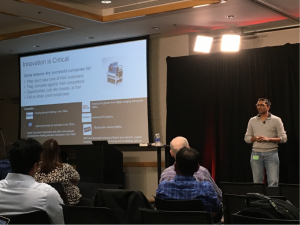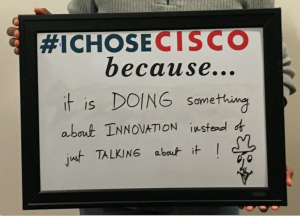“Why does a computer need a fan? I want my computer to be quiet and small!” Steve Jobs actually provoked that question when he started the journey that led to the creation of Apple II nearly four decades ago. And, of course, the journey made history and continues on into new frontiers of technology.
Asking an unsettling question that breaks the status quo – in any era – is one of the key catalysts to ignite innovation exponentially. This is especially true today because of the unprecedented levels of innovation made possible by the digitization of society through the Internet of Everything – the connection of people, processes, data and things.
A provocative question that turns things upside down gets the innovation journey under way. However, it’s just one of many key catalysts we have identified from extensive research and experience that accelerate innovation 10 times or more.
My colleague, Hagit Oron, and I recently had the honor of conducting a highly engaging workshop – Innovation Catalyst – at Cisco’s bi-annual Leadership Forum, an event series tailored for people leaders. Igniting innovation is one of our company’s highest priorities as we transform from a hardware product company into an end-to-end solution provider delivering business outcomes to customers in vertical markets.
Encourage Inclusive, Diverse Culture. First, we emphasized that leaders must foster a climate of innovation with their full teams – not just by hiring a few outliers – but as a collective team to solve problems and develop new products and services. That means assembling teams with a full spectrum of diverse backgrounds, skills, perspectives and approaches, enabling them with the right tools and resources as well as empowering them to innovate collaboratively.
Brilliant, game-changing ideas can come from anyone, anywhere. Much research supports the notion that inclusion, diversity and collaboration ignite innovation. Our own research at Cisco of leaders at 7,500 major companies found that an inclusive environment was most associated with realizing value from IoE.
Innovation Can Be Learned. The great news here is that innovation can be learned using a disciplined approach, which also allows room for flexibility, experimentation, risk-taking, course corrections and even failure. This is where creativity and discipline converge.
We like to reference, “The Innovator’s DNA”, which emphasizes five “discovery skills that distinguish innovative entrepreneurs and executives from ordinary managers”:
- Associating – making connections between two things that don’t seem to go together, a right brain exercise that yields value creation. For example, a bookcase plus a chair leads to a bookcase chair.
- Questioning – Don’t ask, “What is?” Instead, ask “What if?” Like Steve Jobs’ questioning of fans in computers, this is the true engine to associative thinking. Innovative ideas can erupt when asking a series of questions about a situation that challenges the status quo.
- Observing – Leverage different viewpoints on the team to observe a situation with an eye toward answering the questions, which often can lead to a solution.
- Networking – In a climate of trust, sharing and diversity, leaders must facilitate open talk among the team and outside of it to bring different contexts to the situation.
- Experimenting – Enable the team with resources to pilot or prototype new ideas. Remember that failure is an option, but know when to abandon a project that isn’t working. The best entrepreneurs are the ones who accept the very real possibility of failure and proceed anyway.
 In our workshop, we underscored to Cisco’s emerging leaders that their role is more about encouraging and facilitating innovation, as opposed to limiting it to their own active participation in the project. That means taking a less top-down approach and providing their innovation teams with guidance, funding, tools, help “connecting the dots” and other resources to help them brainstorm freely and move forward courageously, which includes removing impediments, such as neutralizing destructive critics on the team who may hinder open participation. This is the foundation of multiplying efforts in any organization and achieving a 10x innovation.
In our workshop, we underscored to Cisco’s emerging leaders that their role is more about encouraging and facilitating innovation, as opposed to limiting it to their own active participation in the project. That means taking a less top-down approach and providing their innovation teams with guidance, funding, tools, help “connecting the dots” and other resources to help them brainstorm freely and move forward courageously, which includes removing impediments, such as neutralizing destructive critics on the team who may hinder open participation. This is the foundation of multiplying efforts in any organization and achieving a 10x innovation.
Be Agile and Flexible. Further, it’s the leader’s role to take divergent ideas and help to converge them into one or a few options in moving forward with a solution. Leaders and their teams also need to be agile and flexible around their execution roadmap to innovation because new discoveries or market changes may unexpectedly crop up along the way. (I’ll address more on strategy execution in my next blog, Part 2 of Catalysts for 10x Innovation.)
We also cautioned that innovation does not always have to be disruptive and it should not be assumed only as “an engineering thing”. Innovation isn’t just about products or solutions, it is also about processes, cost savings and capabilities – both incrementally and exponentially.
These are some of the key catalysts we believe can lead to 10x Innovation. The journey can be frustrating with lots of bumps in the road. However, 10X Innovation is essential not only to survive but also to thrive in today’s hyper competitive, digital world. The rewards for winners can be bountiful.
What do you think are other key catalysts to achieving 10x innovation?
Note: In Part 2 of Cisco’s Leadership Forum’s “Walk the Talk” series, I will share more insights around 10x Innovation focusing more on execution, drawing on remarks from keynoters such as Ashley Goodall, Cisco’s SVP, Leadership and Team Intelligence; Hilary Andrews, Director of Worldwide Channels and Bridget Bisnett, Sr. Director of Partner Marketing, on common myths about strategy execution; and, Greg McKeown, author of the bestseller, “Essentialism: The Disciplined Pursuit of Less.” Stay tuned.

CONNECT WITH US